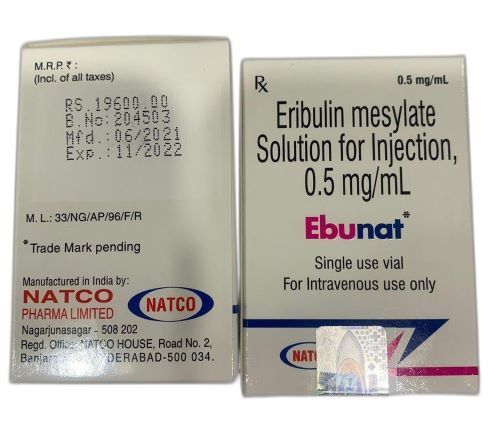Palonosetron Hydrochloride Injection
Product Details:
Palonosetron Hydrochloride Injection Price And Quantity
- 90 INR/Vial
- 10 Vial
Palonosetron Hydrochloride Injection Trade Information
- 1000 Vial Per Week
- 4 Days
- Asia, Australia, Central America, North America, South America, Eastern Europe, Western Europe, Middle East, Africa
- All India, South India, Central India, West India, North India, East India, Gujarat, Karnataka, Kerala, Lakshadweep, Mizoram, Meghalaya, Manipur, Andhra Pradesh, Bihar, Chandigarh, Daman and Diu, Goa, Jharkhand, Odisha, Punjab, Assam, Delhi, Dadra and Nagar Haveli, Andaman and Nicobar Islands, Arunachal Pradesh, Chhattisgarh, Haryana, Himachal Pradesh, Jammu and Kashmir, Madhya Pradesh, Maharashtra, Nagaland, Rajasthan, Sikkim, Tamil Nadu, Telangana, Tripura, Pondicherry, Uttar Pradesh, Uttarakhand, West Bengal
Product Description
Palonosetron hydrochloride is a medication primarily used to prevent nausea and vomiting associated with chemotherapy treatment, particularly in patients undergoing moderately or highly emetogenic (vomit-inducing) chemotherapy. It belongs to the class of drugs known as serotonin 5-HT3 receptor antagonists. Here's some information about palonosetron hydrochloride injection:
1. Indication Palonosetron hydrochloride injection is indicated for the prevention of acute and delayed nausea and vomiting associated with initial and repeat courses of chemotherapy, including cisplatin-based chemotherapy.
2. Mechanism of Action Palonosetron works by selectively blocking serotonin (5-HT3) receptors in the brain, particularly in the area responsible for triggering nausea and vomiting. By inhibiting the action of serotonin, palonosetron helps prevent nausea and vomiting caused by chemotherapy.
3. Dosage Palonosetron hydrochloride injection is typically administered as an intravenous infusion (injection into a vein). The recommended dosage is usually 0.25 mg (25 mcg) administered over 30 seconds to 5 minutes prior to the start of chemotherapy. The dosage and administration schedule may vary depending on factors such as the specific chemotherapy regimen and individual patient factors.
4. Side Effects Common side effects of palonosetron hydrochloride injection may include headache, constipation, diarrhea, dizziness, fatigue, and injection site reactions. Serious side effects such as allergic reactions or changes in heart rhythm are rare but possible.
5. Monitoring Patients receiving palonosetron hydrochloride injection should be monitored for any signs of adverse reactions or complications. Vital signs may be monitored during infusion, and patients should be observed for any signs of allergic reactions or changes in heart rhythm.
6. Precautions and Contraindications Palonosetron hydrochloride injection should be used with caution in patients with a history of allergic reactions to 5-HT3 receptor antagonists or any of the components of the formulation. It should not be used in patients with known or suspected prolongation of the QT interval or those who are allergic to any of the components of the injection.
Palonosetron hydrochloride injection is an important medication in the management of chemotherapy-induced nausea and vomiting. Its use should be guided by a healthcare professional experienced in the administration of chemotherapy and supportive care. As with any medication, it's essential to discuss the potential benefits and risks of palonosetron hydrochloride injection with a healthcare provider before starting treatment.
*FAQS
-
What is Palonosetron Hydrochloride Injection?Palonosetron Hydrochloride Injection is a medication used to prevent nausea and vomiting caused by chemotherapy, particularly in patients undergoing cancer treatment.
-
How does Palonosetron Hydrochloride Injection work?Palonosetron works by blocking the action of serotonin, a natural substance in the body that can cause nausea and vomiting. By inhibiting serotonin receptors in the brain, Palonosetron helps to prevent chemotherapy-induced nausea and vomiting (CINV).
-
Who can use Palonosetron Hydrochloride Injection?Palonosetron Hydrochloride Injection is typically prescribed for adults undergoing chemotherapy treatment for cancer. It may be used alone or in combination with other anti-nausea medications.
-
How is Palonosetron Hydrochloride Injection administered?Palonosetron Hydrochloride Injection is administered intravenously (IV) by a healthcare professional. The dosage and frequency of administration may vary depending on factors such as the specific chemotherapy regimen and individual patient characteristics.
-
What are the common side effects of Palonosetron Hydrochloride Injection?Common side effects of Palonosetron Hydrochloride Injection may include headache, constipation, fatigue, dizziness, and injection site reactions. It is essential to report any severe or persistent side effects to your healthcare provider.
-
Are there any precautions or warnings associated with Palonosetron Hydrochloride Injection?Patients with a history of hypersensitivity to Palonosetron or other serotonin receptor antagonists should not use this medication. Additionally, Palonosetron may interact with certain medications, so it's crucial to inform your healthcare provider about all medications you are taking.
-
Can Palonosetron Hydrochloride Injection be used during pregnancy or breastfeeding?It is essential to discuss the risks and benefits of using Palonosetron Hydrochloride Injection during pregnancy or breastfeeding with your healthcare provider. The safety of this medication in pregnant or breastfeeding women has not been established.
-
How should Palonosetron Hydrochloride Injection be stored?Palonosetron Hydrochloride Injection should be stored according to the manufacturer's instructions, typically at room temperature away from light and moisture. It should be kept out of reach of children and disposed of properly after use.
-
What should I do if I miss a dose of Palonosetron Hydrochloride Injection?If you miss a dose of Palonosetron Hydrochloride Injection, contact your healthcare provider for guidance. It's essential to follow their instructions carefully to maintain the effectiveness of your chemotherapy treatment.
-
Is Palonosetron Hydrochloride Injection available in generic form?Yes, Palonosetron Hydrochloride Injection is available in generic form under various brand names. Generic versions of the medication contain the same active ingredient and are typically less expensive than the brand-name version.

Price:
- 50
- 100
- 200
- 250
- 500
- 1000+







 Contact Us
Contact Us Call Me Free
Call Me Free
